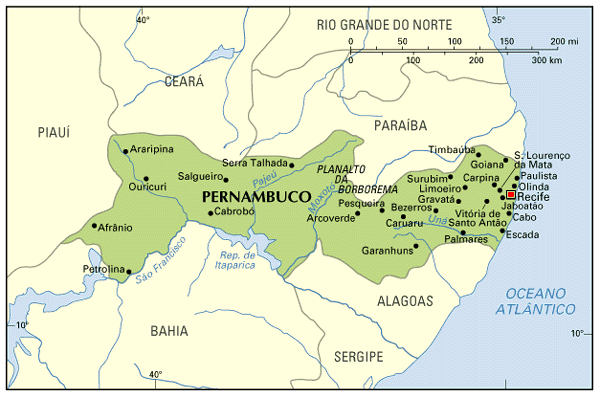Ads by Google
Map of Pernambuco, Brazil
« Back to States of Brazil
« Back to Pernambuco
 Pernambuco is one of the States in Brazilian northeast.
Pernambuco is one of the States in Brazilian northeast.
The capital is Recife, by the Atlantic Ocean; the second largest city is Olinda, in the metropolitan area of Recife. These two cities were occupied by the Dutch from 1630 to 1654; traces of the occupation are still visible in the architecture and costumes of both. The Dutch were attracted by the fertility of the soil, proper for the culture of sugar cane; until today, a good part of the coastal zone of Pernambuco is taken by cane plantations and sugar mills.
The State is clearly divided into three geographical zones:
1) The coastal area (known as "Zona da Mata", or zone of the forest: the area which was once covered by the Atlantic Forest), with a well defined wet season; it´s a strip of a few tens kilometers, where most of population is concentrated. The beach of Porto de Galinhas is in the small city of Ipojuca (not shown on the map), a few kilometers south of the city of Cabo.
2) The Agreste, a transition zone between the coast and the sertão; the climate is not so wet as in the coast, nor so dry as in the sertão. A mountain chain, called Borborema in Pernambuco (and Espinhaço in Minas Gerais and Diamantaina in Bahia) determines the boundaries of the Agreste; Caruaru is one of the largest cities of the Agreste (which, just like the Borborema, exists in all States of northeast). The city of Garanhuns, on the top of Borborema, which used to be famous for the unusually low temperatures, has recently gained a bit more of fame for being the birth city of President Lula.
3) The sertão, where rain is scarce and irregular, average temperatures are high, and the vegetation (called caatinga) is adapted to such tough conditions. Roughly speaking, the sertão is the area to the west of Arcoverde; Serra Talhada, Cabrobó and Salgueiro are important cities of the sertão. Petrolina, although also in the semi-arid zone, has benefited from the irrigation of the river São Francisco, and has become an important center of irrigated agriculture.
The sertão of Pernambuco is known as a dangerous zone. The region is sparsely populated; official authorites have a limited presence; despite frequent police raids, plantations of marijuana are found often (consequence of the lack of alternatives of the local peasants). Buses go in convoys, usually with police scorting; avoid driving around this region.
Back to Top